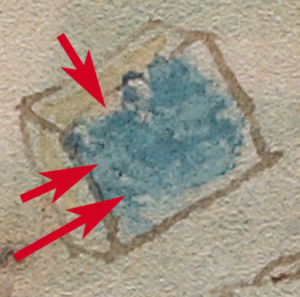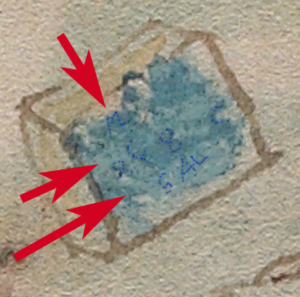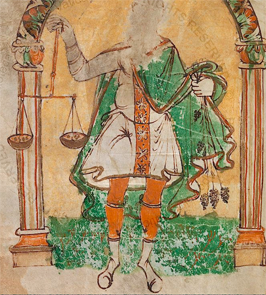
Cesare da Cesto copy of a painting by Leonardo da Vinci showing Leda, Zeus in the guise of a swan, and the two eggs that hatched from their union—one with the sisters, the other with the brothers, Castor and Pollux.
The constellation Gemini is traditionally represented by male twins who were born to the legendary Leda, daughter of King Thestius.
The god Zeus desired Leda, but she was married to the Spartan King, so he came to her in the form of a swan that was fleeing an attacking eagle, thus contriving to fall into her protective arms with the intent to seduce her. In the process he impregnated her and she bore two sets of twins.
In one version, the male twins Castor and Pollux were fraternal twins, one born of King Tyndareus, the other of Zeus. In another version, two eggs result from the illicit union—one hatches into Castor and Pollux, the other into their sisters.
The twins were close, as many twins are, so when Castor was killed, his brother Pollux was devastated and begged Zeus to reunite them. To soothe the twin’s grief and perhaps to atone for his adulterous sin, Zeus turned them into the constellation Gemini, so they could be together forever.
Based on this legend, Greco-Roman images of Gemini typically show male twins closely associated, side-by-side.
The VMS Interpretation of Gemini
In contrast, the Voynich Manuscript Gemini shows a man and a woman clasping hands crossways (a posture that was noted by a number of Voynich researchers) in the center of a figural wheel.
 Let’s look more closely at the details…
Let’s look more closely at the details…
The man wears a traditional belted pleated tunic, boots, and the larger floppier medieval version of a beret. The tunic and hat are painted green.
The woman is decked out in a flowing blue robe with wide sleeves with a scalloped edge (probably trimmed with ruffles or lace). An undergarment or shirt can be seen poking out past the outer sleeves. She has long hair and a blue band across her forehead. It’s interesting that the illustrator included this level of detail in the boots and sleeves considering this drawing is very small.
I wondered whether the VMS image were unusual or whether Gemini traditions changed during the middle ages, so I looked through hundreds of zodiac cycles to study the pattern of evolution.
Traditional Depictions
 In ancient and early medieval zodiacs, male twins are usually shown side-by-side with their arms around each other’s backs as in this Mithraic Gemini (right) from the 2nd century CE (now in the Modena Museum). From about the 9th century, the twins are sometimes shown standing side-by-side holding weapons, musical instruments, or symbolic items. Ancient Geminis were usually nude or wearing scanty togas. The ones in Jewish synagogues were usually clothed.
In ancient and early medieval zodiacs, male twins are usually shown side-by-side with their arms around each other’s backs as in this Mithraic Gemini (right) from the 2nd century CE (now in the Modena Museum). From about the 9th century, the twins are sometimes shown standing side-by-side holding weapons, musical instruments, or symbolic items. Ancient Geminis were usually nude or wearing scanty togas. The ones in Jewish synagogues were usually clothed.
 In Persia, we see a variety of cultural influences.
In Persia, we see a variety of cultural influences.
Some followed the Greco-Roman style of side-by-side twins and some depicted the twins with one body and two heads as in this 11th century “zodiac man” Gemini on the left. The Codex Vindobonensis (Austria? c. 13th C) has a similar image but the twins wear Phrygian caps rather than crowns. It would be easy to assume the two-headed Gemini was based on Janus, the ancient god who symbolized the beginning and the end and was often shown with two heads, but it doesn’t fit well with the legend of Castor and Pollux or the culture that created this variation, so it’s possible it’s based on something else…
 The two-headed Gemini is mostly seen in Hebrew manuscripts or those written by Jews in other languages, so it may have descended from the mosaics in the Jewish synagogues. In the Beit Alpha mosaic (6th C), for example, Gemini is two figures clothed in one garment. Even though each twin has two legs and two arms, it’s an image that could easily be interpreted as conjoined twins because we can’t see what’s going on under the shared clothing.
The two-headed Gemini is mostly seen in Hebrew manuscripts or those written by Jews in other languages, so it may have descended from the mosaics in the Jewish synagogues. In the Beit Alpha mosaic (6th C), for example, Gemini is two figures clothed in one garment. Even though each twin has two legs and two arms, it’s an image that could easily be interpreted as conjoined twins because we can’t see what’s going on under the shared clothing.
Gemini in the Middle Years
 In other cultures, the Greco-Roman tradition of nude male twins (sometimes with and sometimes without genitalia) and, in some cases, a nude male Virgo, continued for a few more centuries. The 11th-century image on the left is a Frankish zodiac that retains Roman influence.
In other cultures, the Greco-Roman tradition of nude male twins (sometimes with and sometimes without genitalia) and, in some cases, a nude male Virgo, continued for a few more centuries. The 11th-century image on the left is a Frankish zodiac that retains Roman influence.
So when did the creators of manuscripts decide to go their own way and clothe the twins?
 One of the earlier examples of the break with tradition is Vatican Reg. Lat. 123, created at the St. Maria Rivipulli monastery c. 1056. The influence is clearly Greco-Roman, but Virgo and Gemini are fully clothed (right), thus imposing Christian modesty on legendary Pagan characters. Note that they also separated the twins with a wider space. The addition of clothing was picked up by some of the English and Frankish illuminators at around the same time, as in Arundel 60 and Royal 13 A XI, but some continued to depict the characters nude.
One of the earlier examples of the break with tradition is Vatican Reg. Lat. 123, created at the St. Maria Rivipulli monastery c. 1056. The influence is clearly Greco-Roman, but Virgo and Gemini are fully clothed (right), thus imposing Christian modesty on legendary Pagan characters. Note that they also separated the twins with a wider space. The addition of clothing was picked up by some of the English and Frankish illuminators at around the same time, as in Arundel 60 and Royal 13 A XI, but some continued to depict the characters nude.
Some illuminators compromised by drawing mostly naked twins in scanty breech cloths (e.g., Egerton 1139, c. 1130s CE) or, in later years, by hiding them behind a bush (the green kind).

Hunterian Psalter, England c. 1170, British Library
In the Hunterian Psalter (left), the twins are fully clothed but display a further innovation… they share a common shield—an iconic representation of their commitment to stick together to defend one another as brothers. This detail is important because the shield becomes widely adopted later, first in England, then in other areas. Note also that the clothing is becoming more local than Roman.
One of the transitional zodiacs is the Stammheim Missal (Getty Ms 64, c. 1170s) which includes a mixture of Greco-Roman and biblical elements. Virgo is female, as in Jewish and Christian zodiacs, Sagittarius is a satyr with an animal head (Jewish), and Capricorn is a Roman-style sea-goat. I thought Gemini might be male-female, but on looking at a higher-resolution image, it appears that both are male.
Gemini Gender Reassigment
 One of the more significant changes in Gemini is the introduction of male-female twins, and one of the earliest unambiguous examples is the c. 1300s Claricia Psalter (right). Why alter a tradition that had remained virtually unbroken for more than 1,000 years? Maybe the female twin was introduced because this psalter was created by nuns—most scriptoria were staffed by males.
One of the more significant changes in Gemini is the introduction of male-female twins, and one of the earliest unambiguous examples is the c. 1300s Claricia Psalter (right). Why alter a tradition that had remained virtually unbroken for more than 1,000 years? Maybe the female twin was introduced because this psalter was created by nuns—most scriptoria were staffed by males.
Hildegard von Bingen’s drawing of Gemini (c. 1200) might be male-female, but it’s hard to tell. There are definite differences between the twins, but the drawing is small and somewhat ambiguous. I suspect it’s male-male.
The Shared Shield
 Coming back to the shield, the Henry of Blois psalter is an Anglo-Norman manuscript created in England in the late 12th or early 13th century that includes two seminude twins, probably both male, leaning toward each other over a shield-like central embellishment. Its identity as a shield is less definite than later manuscripts. If you separate out the blue background and orange cloaks, it’s unusually narrow, more like a decorative element than a shield, but it may have been perceived as a shield because shields became popular from this point on.
Coming back to the shield, the Henry of Blois psalter is an Anglo-Norman manuscript created in England in the late 12th or early 13th century that includes two seminude twins, probably both male, leaning toward each other over a shield-like central embellishment. Its identity as a shield is less definite than later manuscripts. If you separate out the blue background and orange cloaks, it’s unusually narrow, more like a decorative element than a shield, but it may have been perceived as a shield because shields became popular from this point on.
 The introduction of the shield allowed the nude tradition to continue without offending people of more modest sensibilities, as in the Hours of the Virgin (right), which interestingly shows conjoined twins (as does Trinity B-11-7 from c. 1400). Morgan Ms M.153 and Ms M.283 (France) follow the same illustrative tradition. Note that the twins are still typically male. You may also have noticed from the examples (and as mentioned in the previous blog on Libra) that medieval zodiacs are frequently enclosed within circles.
The introduction of the shield allowed the nude tradition to continue without offending people of more modest sensibilities, as in the Hours of the Virgin (right), which interestingly shows conjoined twins (as does Trinity B-11-7 from c. 1400). Morgan Ms M.153 and Ms M.283 (France) follow the same illustrative tradition. Note that the twins are still typically male. You may also have noticed from the examples (and as mentioned in the previous blog on Libra) that medieval zodiacs are frequently enclosed within circles.
Diverging from Tradition
 The Shaftesbury Psalter (England, c. 1237) is similar to the previous three in many ways, but introduces a new motif for the twins. They’re not standing or holding weapons, they’re not hiding behind cloaks or shields. Instead they are clasping each other by the shoulders and floating together in a boat with a nordic-style figure-head. The sign for Capricorn is also unique from other zodiacs. It is bright blue, has been liberated from his fish-tail, and is marching and blowing a horn, a theme possibly inspired by marginal drawings in manuscripts that don’t include zodiacs.
The Shaftesbury Psalter (England, c. 1237) is similar to the previous three in many ways, but introduces a new motif for the twins. They’re not standing or holding weapons, they’re not hiding behind cloaks or shields. Instead they are clasping each other by the shoulders and floating together in a boat with a nordic-style figure-head. The sign for Capricorn is also unique from other zodiacs. It is bright blue, has been liberated from his fish-tail, and is marching and blowing a horn, a theme possibly inspired by marginal drawings in manuscripts that don’t include zodiacs.
The Male-Female Theme Goes Mainstream
 By the mid-to-late 13th century, male-female pairs show up independently of the Claricia Psalter. The Amiens Cathedral, near the north coast of France, has a stone-carved Gemini of a man and woman holding hands and gazing at each other with warm affection, exemplifying the break from Roman tradition. Closer to the source of the Claricia Psalter (and perhaps influenced by it) is Morgan Ms M.280 (right) with male and female clasping one another.
By the mid-to-late 13th century, male-female pairs show up independently of the Claricia Psalter. The Amiens Cathedral, near the north coast of France, has a stone-carved Gemini of a man and woman holding hands and gazing at each other with warm affection, exemplifying the break from Roman tradition. Closer to the source of the Claricia Psalter (and perhaps influenced by it) is Morgan Ms M.280 (right) with male and female clasping one another.
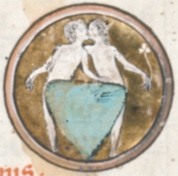 What is not known about these early examples of male-female Geminis is whether illustrators had lost the connection to the legend of Castor and Pollux or if this was a deliberate choice to create their own zodiac traditions at a time when the idea of “courtly love” (medieval chivalry) was gaining popularity.
What is not known about these early examples of male-female Geminis is whether illustrators had lost the connection to the legend of Castor and Pollux or if this was a deliberate choice to create their own zodiac traditions at a time when the idea of “courtly love” (medieval chivalry) was gaining popularity.
In Royal 2 B II, a French Psalter, the figures aren’t just sharing a filial hug, they are kissing one another, in a manuscript created for a nun. After the mid-13th century, many manuscripts include a shield (usually with male twins) or male-female twins clasping one another or holding hands.
Hebrew Traditions
 The Michael Mahzor (right), a Hebrew document from the mid-13th century, has a unique interpretation of the twins. They are drawn with animal heads and face away from one another, with no physical contact. Virgo is also drawn with an animal head, possibly due to the prohibition against graven images.
The Michael Mahzor (right), a Hebrew document from the mid-13th century, has a unique interpretation of the twins. They are drawn with animal heads and face away from one another, with no physical contact. Virgo is also drawn with an animal head, possibly due to the prohibition against graven images.
The Schocken Italian Mahzor, Add 22413 mahzor (c. 1322, lower right), and Oxford Mahzor (1342) similarly have animal heads, but the figures face one another.
The Add. 26896 mahzor (c. 1310s) harks back to older versions with conjoined twins but with animal heads (rather than human heads wearing crowns, as in the Persian Gemini previously shown).
The Dresden Mazhor from 1290 contrasts with the previous examples by having male and female figures with human heads facing one another.
Innovations in the 13th Century
 The twins-in-a-boat was an early 13th-century English creation. Half a century later, in Switzerland, there was another creative variation in which the twins (who may be male and female) are shown in a bathtub (or a wine-stomping barrel). The other zodiac signs in the Swiss manuscript follow traditional patterns for the region, so it’s not clear why the bathtub was added. The bathtub shows up again about a decade later in a manuscript from Liège that follows some of the conventions of central Europe.
The twins-in-a-boat was an early 13th-century English creation. Half a century later, in Switzerland, there was another creative variation in which the twins (who may be male and female) are shown in a bathtub (or a wine-stomping barrel). The other zodiac signs in the Swiss manuscript follow traditional patterns for the region, so it’s not clear why the bathtub was added. The bathtub shows up again about a decade later in a manuscript from Liège that follows some of the conventions of central Europe.
England diverged from tradition again in the early 1300s by drawing the Gemini twins and Virgo as merpersons. Around the same time, a manuscript from Bologna included two sets of twins (possibly because Leda’s swan eggs produced twin boys and twin girls).
Persian Manuscripts
Persian astronomical/astrological manuscripts before the 11th century typically didn’t include a full zodiac but, by the mid-1300s (right), we see male twins with a conjoined fish tail facing one another, holding a head on a staff. Later manuscripts from the 15th century had male conjoined twins sitting crosslegged in eastern-style dress. Clearly the VMS Gemini is not based on this model.
before the 11th century typically didn’t include a full zodiac but, by the mid-1300s (right), we see male twins with a conjoined fish tail facing one another, holding a head on a staff. Later manuscripts from the 15th century had male conjoined twins sitting crosslegged in eastern-style dress. Clearly the VMS Gemini is not based on this model.
The Exception Becomes the Norm
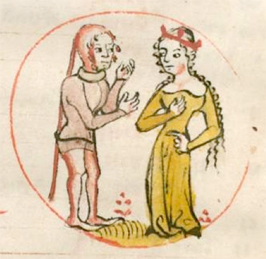 By the 14th century, male-female zodiacs were common in the Anglo-Frankish and Germanic regions (which included most of the Holy Roman Empire, including northern Italy down to Rome and Venice).
By the 14th century, male-female zodiacs were common in the Anglo-Frankish and Germanic regions (which included most of the Holy Roman Empire, including northern Italy down to Rome and Venice).
Not all illustrators made the switch, however. In Tractatus de sphaera (c. 1327), the traditional nude male twins and Virgo with wings are seen.
A Catalan breviary differs from most zodiacs by illustrating Gemini as a pair of male warriors going at each other in a very unbrotherly way.
Zeroing in on the VMS
 By the mid-1300s, Gemini twins start to more closely resemble the VMS Gemini.
By the mid-1300s, Gemini twins start to more closely resemble the VMS Gemini.
There were still many Geminis with shields in France and England, and zodiacs from Genoa (c. 1365) and Padua (c. 1378) that include a traditional pair of nude males, but Germanic manuscripts (especially Swiss, German, and a few of the Czech zodiacs), and a few of the English and French manuscripts, illustrate the idea of “courtly/chivalric love” and are possible precedents. Getty Ms 34 (1395) takes it one step further and has the twins in an unusually tight hug.
Small Stylistic Changes in the 15th Century
Around 1418 there was a re-emergence of nude male twins in both France and Germany, but rather than drawing them like Roman warriors or gods, they look more like young men and boys. A manuscript from Germany takes a different approach and casts the twins as Adam and Eve holding branches against their groins.
The poses change as well. Rather than clasping one hand or hugging each other’s backs, the figures are commonly clasping arms at the elbow or stretching their arms so their hands are on each other’s ribs. To date, I have not found one in which the arms reach across each other as in the VMS.
 By the 1440s, modesty again takes hold in parts of France, and the twins hide behind bushes. In one case conjoined twins hide their shared groin behind an oversized fig leaf (BNF Latin 924) and then the trend swings again toward depicting the twins as completely nude (and not hiding behind anything). In this way the French manuscripts generally differ from the VMS, which shows the twins modestly clothed with high necklines.
By the 1440s, modesty again takes hold in parts of France, and the twins hide behind bushes. In one case conjoined twins hide their shared groin behind an oversized fig leaf (BNF Latin 924) and then the trend swings again toward depicting the twins as completely nude (and not hiding behind anything). In this way the French manuscripts generally differ from the VMS, which shows the twins modestly clothed with high necklines.
While central and northern Europe were developing their own styles, the illuminators in southern Italy retained many of the Roman traditions into the 15th century, including togas, two-legged Taurus, and Virgo with wings (e.g., Codex Bodmer 7 from Naples). A 15th-century zodiac by Cristoforo de Predis of Milan follows the central-European models except that the nude male twins stand back-to-back.
Summary
 The early 15th-century image on the right is not specifically from a zodiac cycle, but I’m posting it because it includes a clasping couple with text around the circle, reminiscent of the VMS, and helps to remind us that the VMS illustrator may have consulted non-zodiacal sources, as well.
The early 15th-century image on the right is not specifically from a zodiac cycle, but I’m posting it because it includes a clasping couple with text around the circle, reminiscent of the VMS, and helps to remind us that the VMS illustrator may have consulted non-zodiacal sources, as well.
It can be seen from the examples that the VMS Gemini bears little resemblance to the Persian, traditional Jewish, or southern Italian zodiacs, and only slightly resembles those from France and Spain. Like Sagittarius with a crossbow, the lizard/dragon Scorpio, and Libra without a figure, the ones that most nearly resemble the VMS in terms of subject matter, pose, and painting style, are the zodiac Geminis from Germanic Europe (the Holy Roman Empire).
J.K. Petersen
© Copyright 2016 J.K. Petersen, All Rights Reserved
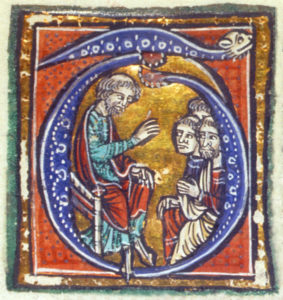 here’s a glyph in the Voynich Manuscript
here’s a glyph in the Voynich Manuscript  To the medieval eye, the “j” shape was not a letter, it was a Latin abbreviation written as a ligature (two shapes combined together for comfortable writing—something I’ve mentioned in previous blogs about the Voynich glyphs). Here’s an example of -ris, from a 14th-century manuscript, decomposed into its parts.
To the medieval eye, the “j” shape was not a letter, it was a Latin abbreviation written as a ligature (two shapes combined together for comfortable writing—something I’ve mentioned in previous blogs about the Voynich glyphs). Here’s an example of -ris, from a 14th-century manuscript, decomposed into its parts.
 But EVA-j is not limited to following the a-glyph. It doesn’t happen often, but it can follow other shapes:
But EVA-j is not limited to following the a-glyph. It doesn’t happen often, but it can follow other shapes:
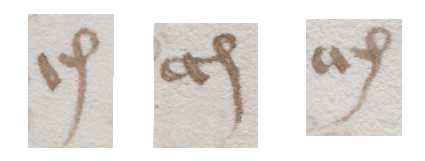


 back in January (and mentioned in even earlier blogs), the gallows character on the right may be composed of two parts, as well. Even if it is, what the glyph means is anyone’s guess. This shape has different interpretations in different languages—it can be “Il” in French, “lis” in Latin, “Item” in German, and sometimes even a very abbreviated “peri” in Greek. It’s also possible that it’s a capitulum, modifier, or marker, and the similarity to the looped shape in “aj” is coincidental.
back in January (and mentioned in even earlier blogs), the gallows character on the right may be composed of two parts, as well. Even if it is, what the glyph means is anyone’s guess. This shape has different interpretations in different languages—it can be “Il” in French, “lis” in Latin, “Item” in German, and sometimes even a very abbreviated “peri” in Greek. It’s also possible that it’s a capitulum, modifier, or marker, and the similarity to the looped shape in “aj” is coincidental. One other detail worth noting is that some of the EVA-d characters have a straight rather than looping stem. Is it possible this shape is a short-stemmed -cis or “j” rather than a “d”? In some places the distinction between them is more dramatic than in this example but are they different enough to be considered different glyphs?
One other detail worth noting is that some of the EVA-d characters have a straight rather than looping stem. Is it possible this shape is a short-stemmed -cis or “j” rather than a “d”? In some places the distinction between them is more dramatic than in this example but are they different enough to be considered different glyphs?
















